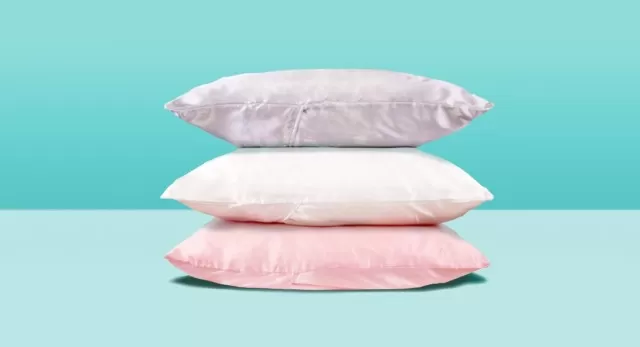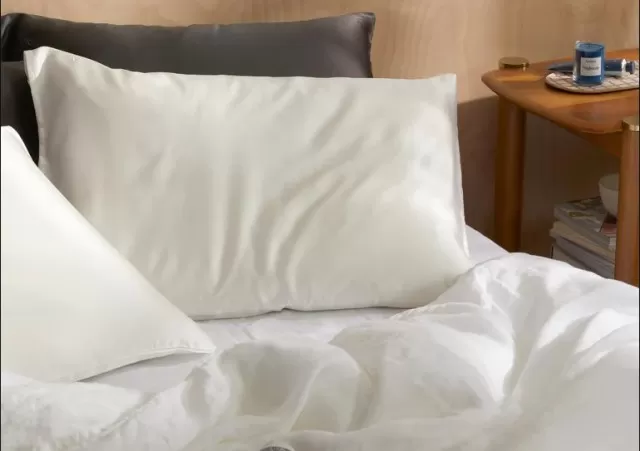While the luxurious texture of silk bedding might seem daunting to wash, it can be safely cleaned at home, either by hand or with a machine.
Silk, being a natural fiber with protein composition, is actually easier to wash than one might expect.
Silk is derived from silkworm cocoons that are boiled in hot water until the fibers unravel. This luxurious fabric is hypoallergenic and has natural repellent properties against moths and dust mites, making it an excellent choice for those with allergies or asthma.
Silk is also beneficial for individuals with sensitive, dry, or eczema-prone skin, as it helps wick away moisture and maintains a cool feeling throughout the night.
In addition, we will provide you with guidance on how to Treat Stains and properly dry silk bedding to ensure it retains its exquisite appearance and performance.
Clean Silk Sheets and Pillowcases

Washing silk sheets and pillowcases requires special care to preserve their delicate nature.
Hand washing is generally considered the safest method for cleaning silk, but machine washing can also be done with caution.
Hand-Washing Silk:.
Step 1: Pre-treat and prepare the soap solution:.
If there are odors, soak the silk fabric in lukewarm water mixed with 1/4 cup of White Vinegar before washing.
Fill a sink or washtub/basin with cool water and add the appropriate amount of silk detergent according to the label instructions.
Step 2: Wash the pillowcases:.
Turn the pillowcases inside out and submerge them in the Soapy Water.
If washing multiple silk items, wash them separately or with like colors. Gently agitate the water and silk with your hands, avoiding excessive rubbing.
Do not let the silk soak for more than 30 minutes.
Step 3: Rinse and dry:.
Rinse the silk items with cool water until all soap is removed.
Gently press the water out of the fabric, avoiding wringing. Air dry the silk pieces on a drying rack or lay them flat on a surface.
Use padded or flocked hangers instead of those with metal clips. The silk will become wrinkled after washing, so follow the steps for drying and storing silk to remove wrinkles.
Machine-Washing Silk:.
Step 1: Set the machine settings:.
Look for a silk cycle option on your washing machine.
If unavailable, use the delicate cycle, which mimics handwashing. Select a cold water temperature and set the spin to low.
It’s essential to wash silk separately from other fabrics, especially cotton clothing or towels. Also, wash silk pillowcases with like colors and place smaller items in mesh laundry bags to prevent tearing.
Step 2: Wash the silk items:.
Place the silk items in the washing machine and start the cycle.
Avoid letting the silk soak for more than 30 minutes. Once the cycle is complete, promptly remove the silk pieces from the washer.
Step 3: Dry the silk:.
Air dry the silk items on a drying rack or lay them flat.
Avoid hangers with metal clips, as they can damage the fabric. If the silk becomes wrinkled during drying, refer to the steps for removing wrinkles.
By following these guidelines, you can effectively clean silk sheets and pillowcases while preserving their beauty and quality.
Remove Stains from a Silk Pillowcase

Spot-cleaning silk pillowcases can sometimes lead to larger stains that can permanently damage the fabric.
If you have a stain on your silk pillowcase, follow these steps:.
Treat the stain:.
Use a stain solution specifically designed for silk fabric.
Apply the solution to the affected areas of the pillowcase. Gently blot the stain with cool water and the stain remover using your finger or a brush.
Avoid rubbing or pulling at the stain, as this can cause damage to the delicate silk material.
Wash the pillowcase:.
After treating the stain, wash the entire pillowcase using one of the cleaning methods mentioned earlier.
Top Tip: Remember to wash your pillows every few months.
Pillows can accumulate bacteria, dust, dirt, and sweat over time, so regular washing is important to maintain cleanliness.
Dry and Store Silk

Regardless of the method you choose to wash silk items, it is important to avoid using a dryer or line drying them in direct sunlight, as these can cause silk to lose its luster and shrink.
To remove wrinkles from silk, handheld steamers are effective and gentle, as silk does not require traditional ironing.
If ironing is necessary, use the lowest temperature setting and place a pressing cloth between the silk item and the iron to prevent damage.
For storage, it is recommended to hang silk items on hangers or store them in hanging storage bags.
This helps protect them from yellowing, dust, and pests. These guidelines apply not only to silk pillowcases but also to silk clothing.
*The information is for reference only.